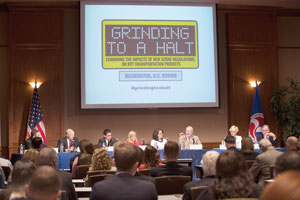Groups Say Road Funding Threatened by Proposal on Ground Ozone Limit

At a U.S. Chamber of Commerce event here July 22, representatives of transportation groups and other industries used metropolitan Washington as a case study on how an Environmental Protection Agency final rule expected in October could lead the government to curtail spending on transportation projects.
The Chamber and its allies argued that proposed changes in EPA’s National Ambient Air Quality Standards for Ozone give the agency the power to cancel federal contributions to highway transportation projects if a county or city is significantly beyond the proposal for a new cap of 65 parts per billion, down from the current ceiling of 75 ppb.
“This is unfair after the pain regional motorists have gone through,” said Lon Anderson, managing director of government affairs for AAA Mid-Atlantic. State governments in Maryland and Virginia recently decided to embark on significant transportation improvement campaigns, and the new rule means federal contributions are in danger.
“We’ve made huge progress on emissions, but stricter regulations could stop the progress we’re making to ease congestion,” Anderson said.
Ozone is a gas made of three oxygen atoms. Large amounts at ground level are considered unhealthful, but a thick layer of O3 at high altitude is a beneficial screen against radiation.
The rule change could prove to be counterproductive, said Richard Parsons, vice chairman of the Suburban Maryland Transportation Alliance. When a completed road project allows vehicles to move quickly, it helps reduce emissions because cars and trucks emit less if they don’t have to sit in traffic and idle.
“This regulation doesn’t consider congestion’s effect on air pollution. It’s a nonsensical sanction that makes things worse,” Parsons said.
EPA said the Chamber’s scenario is not likely to occur and that the withholding of transportation funds never has happened to date.
“Violating a standard, or being designated as nonattainment for a standard, does not jeopardize a community’s highway or transit funds,” the agency said.
“Withholding these funds is an extraordinary measure that would only be considered if a state repeatedly failed to take actions required by the Clean Air Act. If an area acts in good faith by developing and implementing an initial plan to attain the standard, but does not attain by its attainment date, highway and transit funds will not be withheld,” the EPA statement said.
David Birtwhistle, CEO of the Northern Virginia Transportation Alliance, said his area has enjoyed a significant drop in “code red” air pollution warnings to about three per year from 17 a year in the 1980s.
Constructing a new Wilson Bridge across the Potomac helped speed traffic and reduce emissions, he said, and now he wants to proceed with work on Interstate 66 and does not want federal funding held up.
Virginia’s government has said it wants to use a public-private partnership, or P3, to improve I-66. AAA’s Anderson said he worries that an EPA threat to federal transportation funding will make private investors less likely to participate in P3s.
The event was part of the Chamber’s rollout of a report on the rule. One section said the problem could be very pressing in Western states, where naturally occurring background ozone is higher than in the Eastern half of the country.
Such conditions mean even modest amounts of human activity would put ozone levels over the proposed new cap.
Greg Cohen, CEO of the Highway Users Alliance, said it is disappointing that EPA is proceeding with the rule at the same time the Senate is making progress on a highway bill.
“Technological progress on vehicles and engines is what improves air quality — not canceling highway projects. The worry is that these needed projects will never get there if this rule goes forward,” Cohen said.
Nick Goldstein, assistant general counsel of the American Road and Transportation Builders Association, said tightening the ozone level now is premature because many cities and counties are only now coming into compliance with the 2008 standard.
“We still don’t know all of the benefits of the 2008 standard,” he said. “Let’s wait and see what happens with the 2008 standard.”

